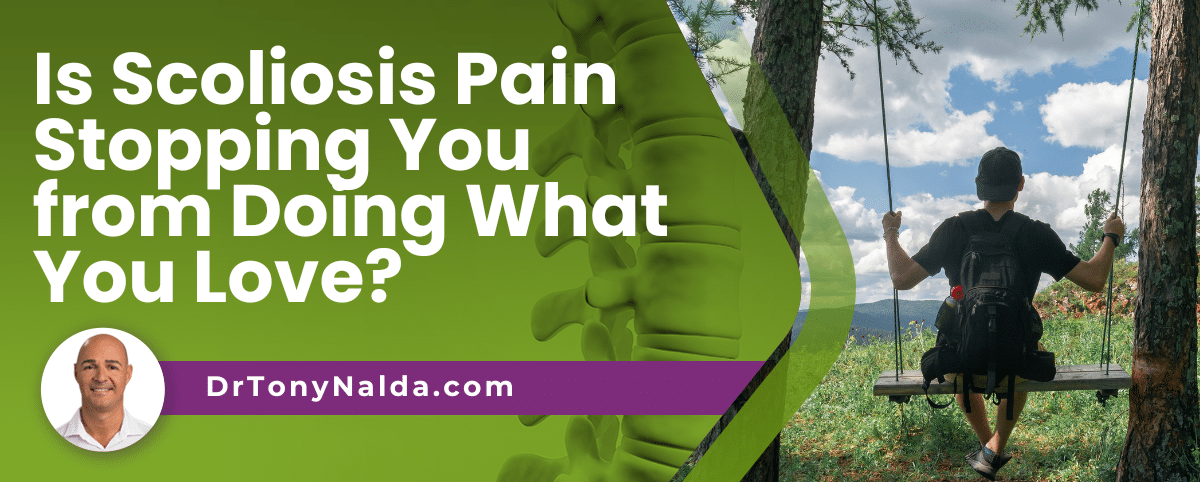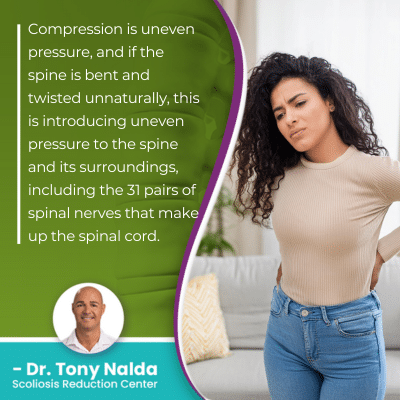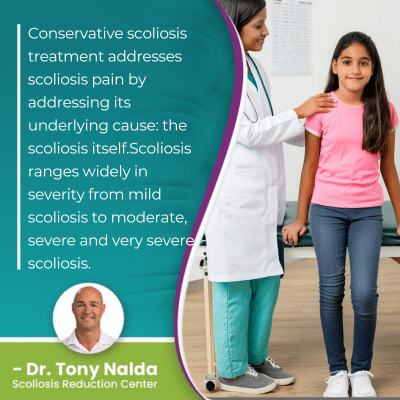Is Scoliosis Pain Stopping You from Doing What You Love?

The effects of scoliosis, including pain, will be more noticeable alongside severity. The signs of mild scoliosis can be subtle, while the symptoms of moderate and severe scoliosis can be overt and bring patients in for a diagnosis and treatment options.
No two cases of scoliosis are the same, and not everyone experiences scoliosis pain, but for those that do, it can include muscle pain, back pain, and pain that radiates into the extremities. If scoliosis is stopping you from doing what you love, it's time for treatment.
One of the most significant differences between how adults and children experience scoliosis is pain, so let's start with why.
Table of Contents
Scoliosis Pain: What Causes It?
Scoliosis is a structural spinal condition that almost seven million people are currently living with in the United States alone.
As the leading spinal condition facing school-aged children, childhood scoliosis needs to be taken seriously, particularly as a progressive condition triggered by growth.
Scoliosis causes an unnatural spinal curve to develop that bends to the side and twists unnaturally, making it a complex 3-dimensional condition that requires treatment.
Scoliosis isn't always painful, and the biggest factor affecting pain is patient age; scoliosis doesn't become a compressive condition until skeletal maturity has been reached.
A growing spine is constantly being lengthened, and this motion counteracts the compressive force of the unnatural spinal curve, and it's compression of the spine and its surrounding nerves and muscles is the main cause of scoliosis pain.
So for children, while muscle pain is common, back pain and pain that radiates into the extremities due to nerve compression is more closely associated with adult scoliosis.
Scoliosis pain is caused by the condition's uneven forces, and as a progressive condition, the nature of scoliosis is to get worse over time, meaning even if a patient's scoliosis isn't painful at the time of diagnosis, it can become more painful over time.
What Does Scoliosis Pain Feel Like?
So for children, scoliosis pain is most likely to involve muscle pain, and this can involve sore muscles, strained muscle, muscle spasms, and unbalanced muscles.
It's not just the spine that has to maintain its natural curves and alignment, but also the job of its surrounding muscles to optimally support and stabilize the spine.
Muscle Pain
Children with scoliosis discuss feeling the back is tighter and stiffer on one side, and this can be due to a muscle imbalance; scoliosis can cause the spine's surrounding muscles to become unbalanced as the muscles surrounding the unnaturally-curved spine are being pulled in different directions.
The muscles on one side of the spine can become weak from underuse and muscles on the other side can become stretched and sore from overuse.
Scoliosis patients also mention the feeling of being pulled to one side, and this is common as the spine is bending unnaturally to the side, shifting the body's center of gravity, and this can also cause changes to balance, coordination, and gait.
Back Pain
 Back pain is likely to affect adults, and in most cases, the area of the back and body surrounding the affected spinal section is going to feel the majority of its direct effects.
Back pain is likely to affect adults, and in most cases, the area of the back and body surrounding the affected spinal section is going to feel the majority of its direct effects.
Scoliosis pain can be felt in the cervical spine, thoracic spine, and the lumbar spine, or in more than one section as scoliosis can disrupt the biomechanics of the entire spine.
Back pain can be structural as scoliosis is a structural spinal condition, and having vertebrae unnaturally tilted and twisted can be painful as it introduces uneven forces and wear to the parts of the spine.
Nerve Pain
Once scoliosis becomes compressive in adulthood, nerve pain is common; in fact, the main symptom that brings adults in to see me for a diagnosis and treatment is pain that radiates into the arms, hands, legs, and feet due to nerve compression.
Compression is uneven pressure, and if the spine is bent and twisted unnaturally, this is introducing uneven pressure to the spine and its surroundings, including the 31 pairs of spinal nerves that make up the spinal cord.
If a nerve is compressed, impinged, and/or pinched, it can cause pain felt anywhere along its pathway, which can be extensive.
For those who have experienced nerve-related back pain, it's often considered one of the most severe types of back pain, and once scoliosis becomes compressive, nerves compression and pain can be a symptom disrupting quality of life.
Scoliosis Pain and Activities
If your scoliosis pain is keeping you from activities you love, or making it difficult to stay active, it's time to start treatment; the best way to minimize the effects of scoliosis, including pain, is to be proactive with treatment.
Pain is a symptom of scoliosis, and while pain medication can help with pain relief, this is only addressing the pain as a symptom, but not its underlying cause for long-term results: the condition itself.
If back pain is problematic, treatment that works towards increasing the spine's flexibility and strength can help, and treatment also focuses on strengthening the spine's surrounding muscles so they can optimally support the spine.
Treatment will address any muscular imbalance and strengthening muscles improves muscle pain, while also helping with structural back pain as spinal support and stabilization increases.
Scoliosis causes the spine to become increasingly unbalanced and unstable, and this type of instability will cause increasing levels of back pain, particularly in older adults for whom age-related spinal degeneration is also a factor: degenerative scoliosis pain.
How a diagnosis of scoliosis is responded to with treatment is key, and while a traditional surgical response has been in place for many years, this approach isn't aligned with the spine's movement-based design.
Nonsurgical Scoliosis Treatment and Scoliosis Pain
If scoliosis pain is making it difficult to stay active, the last thing you want to do is start leading a sedentary lifestyle; this will only make back pain worse in the long term.
Spinal fusion can straighten a bent spine, but the way it does so, by fusing multiple vertebrae into old solid bone and adding metal rods to the spine to hold it in place is invasive and risky, and many patients are disappointed to find their back pain has increased, along with spinal rigidity making certain activities difficult.
 In addition, a fused spine is weaker and more vulnerable to injury, but fortunately, there is a more natural and less-invasive nonsurgical treatment option available: conservative treatment.
In addition, a fused spine is weaker and more vulnerable to injury, but fortunately, there is a more natural and less-invasive nonsurgical treatment option available: conservative treatment.
Conservative scoliosis treatment addresses scoliosis pain by addressing its underlying cause: the scoliosis itself.
By addressing the structural spinal condition, its symptoms are addressed as the condition is improved.
Conservative treatment combines multiple scoliosis-specific treatment disciplines so conditions can be impacted on every level: chiropractic care, physical therapy, scoliosis exercises, and rehabilitation for further healing and stabilizing the spine.
As the structural nature of scoliosis is addressed in the form of a curvature reduction, this is restoring the spine's biomechanics, and reversing/improving the condition's effects.
Scoliosis pain caused by compression is due to the condition's uneven forces, so if those are reduced with proactive treatment, its effects are also improved, and this would include scoliosis pain caused by sore muscles, back, and nerve pain.
Conclusion
Scoliosis pain doesn't have to keep you from what you love; in fact, there are a number of famous celebrities and athletes that have fulfilled their life's goals despite having scoliosis.
Scoliosis pain can be improved by proactive treatment that's addressing the underlying structural nature of the spinal condition.
Scoliosis pain can involve sore and unbalanced muscles, back pain, and nerve pain felt throughout the body, and if pain is making it difficult to stay active or participate in once-loved sports, a functional treatment approach can help.
Conservative treatment works by preserving as much of the spine's natural strength and function as possible, and a healthier spine is one that's not going to be as painful.
Scoliosis pain, along with other condition effects such as postural changes, will get worse alongside progression, and the more severe a condition becomes, the more complex it is to treat, hence the benefit of proactive treatment.
Here at the Scoliosis Reduction Center, scoliosis pain is addressed proactively by starting treatment as close to the time of diagnosis as possible; while there are never treatment guarantees, with early detection and intervention, there are fewer limits to what nonsurgical treatment can achieve.
Scoliosis pain doesn't have to shape your life if you take control with treatment that addresses scoliosis on every level.
Dr. Tony Nalda
DOCTOR OF CHIROPRACTIC
After receiving an undergraduate degree in psychology and his Doctorate of Chiropractic from Life University, Dr. Nalda settled in Celebration, Florida and proceeded to build one of Central Florida’s most successful chiropractic clinics.
His experience with patients suffering from scoliosis, and the confusion and frustration they faced, led him to seek a specialty in scoliosis care. In 2006 he completed his Intensive Care Certification from CLEAR Institute, a leading scoliosis educational and certification center.
About Dr. Tony Nalda
 Ready to explore scoliosis treatment? Contact Us Now
Ready to explore scoliosis treatment? Contact Us Now





